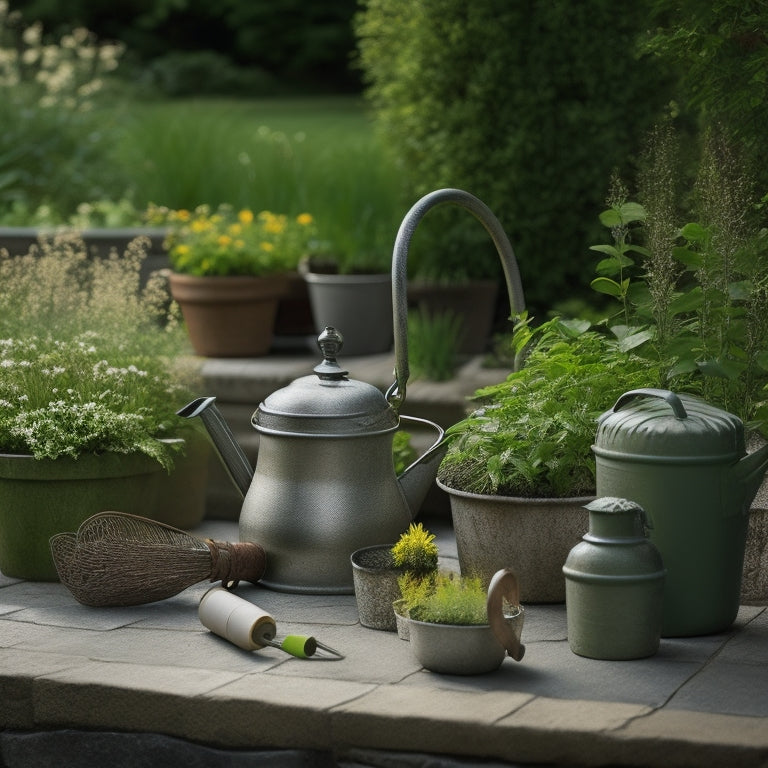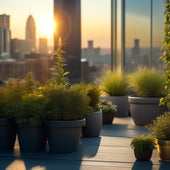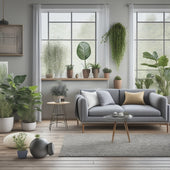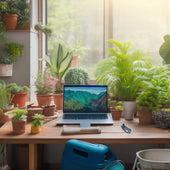
3 Simple Tips for Watering Your DIY Planters
Share
When it comes to watering your DIY planters, you'll want to tailor your approach to the specific needs of your plants and planters. Start by understanding the unique requirements of your plants, including their preferred soil moisture levels and responses to different watering frequencies. Next, avoid common mistakes like overwatering and using non-well-draining potting mixes, which can lead to root rot and waterlogged soil. Finally, establish a watering schedule based on the top 1-2 inches of soil feeling dry to the touch, and be prepared to adjust as environmental conditions change - and by digging deeper, you'll uncover the secrets to long-term planter success.
Key Takeaways
• Water your DIY planters when the top 1-2 inches of soil feel dry to the touch to avoid overwatering and root rot.
• Adjust your watering schedule based on the specific needs of your plants, taking into account their type, potting mix, and environmental conditions.
• Observe your plants' responses to different watering frequencies and adjust accordingly to promote healthy growth and development.
• Ensure your planters have adequate drainage holes to prevent waterlogged soil conditions and root damage.
• Monitor your plants for signs of overwatering, such as yellowing leaves and droopy stems, and intervene promptly to prevent further damage.
Understanding Your Planter's Needs
Before you can effectively water your DIY planter, you need to understand the specific needs of the plants and materials that make up your unique container.
Different plants have varying requirements for soil moisture, and it's crucial to know what your plants need to thrive. For instance, succulents prefer dry soil, while ferns require consistent moisture. Understanding your plants' needs will help you determine the right watering schedule.
The type of planter you're using also plays a significant role in determining your watering strategy. Porous planters like terra cotta or wood allow for better drainage, while non-porous planters like plastic or ceramic may retain more water.
This affects how often you need to water, as well as how much water your plants receive. By considering the specific needs of your plants and planter, you'll be able to provide the right amount of moisture, ensuring your DIY planter remains healthy and flourishing.
Watering Techniques to Avoid
When it comes to watering your DIY planter, there are several common mistakes to steer clear of, including overwatering, which can cause root rot and other problems. Overwatering hazards include waterlogged soil, reduced oxygen for roots, and increased risk of pests and diseases. To avoid these issues, it is crucial to implement proper drainage solutions.
| Watering Technique | Reason to Avoid | Solution |
|---|---|---|
| Overwatering | Causes root rot and oxygen deprivation | Check soil moisture before watering |
| Watering too frequently | Leads to waterlogged soil | Water only when necessary |
| Not using a well-draining potting mix | Prevents excess water from draining | Use a mix with perlite or vermiculite |
| Not providing adequate drainage holes | Traps excess water in the planter | Add holes to the bottom of the planter |
| Ignoring plant signs of overwatering | Fails to address the issue promptly | Monitor plants for yellowing leaves or droopy stems |
Effective Watering Schedules
Establishing an effective watering schedule requires careful consideration of your DIY planter's specific needs, including the type of plants, potting mix, and climate. You'll want to make sure your plants receive the ideal moisture levels to thrive.
Start by observing your plants' responses to different watering frequencies. For example, if you notice the soil drying out too quickly, you may need to water more frequently. Conversely, if the soil remains consistently waterlogged, you can reduce the frequency.
As the seasons change, make seasonal adjustments to your watering schedule. During hotter months, your plants may require more frequent watering to prevent dehydration. In cooler months, you can reduce watering to prevent root rot.
A general rule of thumb is to water your DIY planters when the top 1-2 inches of soil feel dry to the touch. By implementing an effective watering schedule, you'll be able to provide your plants with the right amount of moisture, promoting healthy growth and development.
With a little practice and observation, you'll be well on your way to becoming a watering pro and enjoying the benefits of your thriving DIY planters.
Frequently Asked Questions
How Do I Prevent Water From Dripping Onto My Floors or Patio?
When you're dealing with pesky water drips, you're not alone!
To prevent water from dripping onto your floors or patio, you'll want to get creative.
Try using drip trays or a water catcher under your planters to catch any excess water.
These clever solutions will save you from slippery messes and water damage.
Plus, they'll give you peace of mind, so you can focus on enjoying your beautifully watered plants!
Can I Use Rainwater or Recycled Water for My Planters?
Guess what? You're already thinking like a green thumb!
Using rainwater or recycled water for your planters is a fantastic idea. Rainwater benefits your plants by being free of chemicals and minerals found in tap water.
However, when using recycled water, consider the source and treatment process to guarantee it's safe for your plants.
Make sure to store it properly to avoid contamination.
What Are Some Signs of Overwatering in DIY Planters?
You're doing great with your DIY planters, but now it's time to watch out for overwatering!
You'll know it's happening if you notice yellow leaves or soft, mushy stems.
Check the soil daily, and if it's consistently waterlogged, it's a sign of trouble.
Root rot can set in quickly, killing your plants.
Make sure to drain excess water, and avoid getting waterlogged soil to prevent these issues.
Do I Need to Adjust Watering for Planters in Shaded Areas?
When you're hiking on a cloudy day, you don't sweat as much, right?
It's similar with your shaded planters - they don't dry out as quickly as those in direct sunlight.
To adjust your watering schedule, keep in mind that shaded planters retain moisture longer.
Check the soil more frequently, and water only when it feels dry to the touch.
This guarantees you're not overwatering, which can be detrimental to your plants' health.
How Often Should I Clean My DIY Planter's Drainage Holes?
You'll want to clean your DIY planter's drainage holes regularly to guarantee planter health.
Clogged holes can lead to waterlogged soil and root rot, so it's essential to prioritize drainage maintenance.
Check your planter's holes every 1-2 weeks, and gently remove any debris or sediment with a small brush or toothpick.
Conclusion
As you tend to your DIY planters, remember that watering is an art that requires finesse.
Don't drown your plants in a sea of good intentions - instead, strike the right balance.
By understanding your planter's needs, avoiding common mistakes, and establishing a thoughtful watering schedule, you'll be well on your way to nurturing thriving, vibrant plants.
With every careful pour, you're conducting a symphony of growth, and your plants will flourish under your attentive baton.
Related Posts
-

Why Choose Cinder for Your Rooftop Garden Planters
You choose cinder for your rooftop garden planters because they offer a unique combination of durability, versatility...
-

Why Choose Cinder for Your Rooftop Garden Planters
You choose cinder for your rooftop garden planters because they offer a unique combination of durability, versatility...
-

Why Choose Cinder for Your Rooftop Garden Planters
You choose cinder for your rooftop garden planters because they offer a unique combination of durability, versatility...
-

Why Choose Cinder for Your Rooftop Garden Planters
You choose cinder for your rooftop garden planters because they offer a unique combination of durability, versatility...
-

Why Choose Cinder for Your Rooftop Garden Planters
You choose cinder for your rooftop garden planters because they offer a unique combination of durability, versatility...
-

Why Choose Cinder for Your Rooftop Garden Planters
You choose cinder for your rooftop garden planters because they offer a unique combination of durability, versatility...
-

Why Choose Cinder for Your Rooftop Garden Planters
You choose cinder for your rooftop garden planters because they offer a unique combination of durability, versatility...
-

Why Choose Cinder for Your Rooftop Garden Planters
You choose cinder for your rooftop garden planters because they offer a unique combination of durability, versatility...
-

Why Choose Cinder for Your Rooftop Garden Planters
You choose cinder for your rooftop garden planters because they offer a unique combination of durability, versatility...
-

Why Choose Cinder for Your Rooftop Garden Planters
You choose cinder for your rooftop garden planters because they offer a unique combination of durability, versatility...
-

Why Choose Cinder for Your Rooftop Garden Planters
You choose cinder for your rooftop garden planters because they offer a unique combination of durability, versatility...
-

Why Choose Cinder for Your Rooftop Garden Planters
You choose cinder for your rooftop garden planters because they offer a unique combination of durability, versatility...
-

Why Choose Cinder for Your Rooftop Garden Planters
You choose cinder for your rooftop garden planters because they offer a unique combination of durability, versatility...
-

Why Choose Cinder for Your Rooftop Garden Planters
You choose cinder for your rooftop garden planters because they offer a unique combination of durability, versatility...
-

Why Choose Cinder for Your Rooftop Garden Planters
You choose cinder for your rooftop garden planters because they offer a unique combination of durability, versatility...
-

Why Choose Cinder for Your Rooftop Garden Planters
You choose cinder for your rooftop garden planters because they offer a unique combination of durability, versatility...
-

Why Choose Cinder for Your Rooftop Garden Planters
You choose cinder for your rooftop garden planters because they offer a unique combination of durability, versatility...
-

Why Choose Cinder for Your Rooftop Garden Planters
You choose cinder for your rooftop garden planters because they offer a unique combination of durability, versatility...
-

Why Choose Cinder for Your Rooftop Garden Planters
You choose cinder for your rooftop garden planters because they offer a unique combination of durability, versatility...
-

Why Choose Cinder for Your Rooftop Garden Planters
You choose cinder for your rooftop garden planters because they offer a unique combination of durability, versatility...
-

Why Choose Cinder for Your Rooftop Garden Planters
You choose cinder for your rooftop garden planters because they offer a unique combination of durability, versatility...
-

Why Choose Cinder for Your Rooftop Garden Planters
You choose cinder for your rooftop garden planters because they offer a unique combination of durability, versatility...
-

Why Choose Cinder for Your Rooftop Garden Planters
You choose cinder for your rooftop garden planters because they offer a unique combination of durability, versatility...
-

Why Choose Cinder for Your Rooftop Garden Planters
You choose cinder for your rooftop garden planters because they offer a unique combination of durability, versatility...
-

Why Choose Cinder for Your Rooftop Garden Planters
You choose cinder for your rooftop garden planters because they offer a unique combination of durability, versatility...
-

Why Choose Cinder for Your Rooftop Garden Planters
You choose cinder for your rooftop garden planters because they offer a unique combination of durability, versatility...
-

Why Choose Cinder for Your Rooftop Garden Planters
You choose cinder for your rooftop garden planters because they offer a unique combination of durability, versatility...
-

Why Choose Cinder for Your Rooftop Garden Planters
You choose cinder for your rooftop garden planters because they offer a unique combination of durability, versatility...
-

Selecting the Right Planter Dimensions for Your Space
When selecting the right planter dimensions for your space, you'll want to carefully consider the available area, mea...
-

Selecting the Right Planter Dimensions for Your Space
When selecting the right planter dimensions for your space, you'll want to carefully consider the available area, mea...
-

Selecting the Right Planter Dimensions for Your Space
When selecting the right planter dimensions for your space, you'll want to carefully consider the available area, mea...
-

Selecting the Right Planter Dimensions for Your Space
When selecting the right planter dimensions for your space, you'll want to carefully consider the available area, mea...
-

Selecting the Right Planter Dimensions for Your Space
When selecting the right planter dimensions for your space, you'll want to carefully consider the available area, mea...
-

Selecting the Right Planter Dimensions for Your Space
When selecting the right planter dimensions for your space, you'll want to carefully consider the available area, mea...
-

Selecting the Right Planter Dimensions for Your Space
When selecting the right planter dimensions for your space, you'll want to carefully consider the available area, mea...
-

Selecting the Right Planter Dimensions for Your Space
When selecting the right planter dimensions for your space, you'll want to carefully consider the available area, mea...
-

Selecting the Right Planter Dimensions for Your Space
When selecting the right planter dimensions for your space, you'll want to carefully consider the available area, mea...
-

Selecting the Right Planter Dimensions for Your Space
When selecting the right planter dimensions for your space, you'll want to carefully consider the available area, mea...
-

Selecting the Right Planter Dimensions for Your Space
When selecting the right planter dimensions for your space, you'll want to carefully consider the available area, mea...
-

Selecting the Right Planter Dimensions for Your Space
When selecting the right planter dimensions for your space, you'll want to carefully consider the available area, mea...
-

Selecting the Right Planter Dimensions for Your Space
When selecting the right planter dimensions for your space, you'll want to carefully consider the available area, mea...
-

Selecting the Right Planter Dimensions for Your Space
When selecting the right planter dimensions for your space, you'll want to carefully consider the available area, mea...
-

Selecting the Right Planter Dimensions for Your Space
When selecting the right planter dimensions for your space, you'll want to carefully consider the available area, mea...
-

Selecting the Right Planter Dimensions for Your Space
When selecting the right planter dimensions for your space, you'll want to carefully consider the available area, mea...
-

Selecting the Right Planter Dimensions for Your Space
When selecting the right planter dimensions for your space, you'll want to carefully consider the available area, mea...
-

Selecting the Right Planter Dimensions for Your Space
When selecting the right planter dimensions for your space, you'll want to carefully consider the available area, mea...
-

Selecting the Right Planter Dimensions for Your Space
When selecting the right planter dimensions for your space, you'll want to carefully consider the available area, mea...
-

Selecting the Right Planter Dimensions for Your Space
When selecting the right planter dimensions for your space, you'll want to carefully consider the available area, mea...
-

Selecting the Right Planter Dimensions for Your Space
When selecting the right planter dimensions for your space, you'll want to carefully consider the available area, mea...
-

Selecting the Right Planter Dimensions for Your Space
When selecting the right planter dimensions for your space, you'll want to carefully consider the available area, mea...
-

Selecting the Right Planter Dimensions for Your Space
When selecting the right planter dimensions for your space, you'll want to carefully consider the available area, mea...
-

Selecting the Right Planter Dimensions for Your Space
When selecting the right planter dimensions for your space, you'll want to carefully consider the available area, mea...
-

Selecting the Right Planter Dimensions for Your Space
When selecting the right planter dimensions for your space, you'll want to carefully consider the available area, mea...
-

Selecting the Right Planter Dimensions for Your Space
When selecting the right planter dimensions for your space, you'll want to carefully consider the available area, mea...
-

Selecting the Right Planter Dimensions for Your Space
When selecting the right planter dimensions for your space, you'll want to carefully consider the available area, mea...
-

Selecting the Right Planter Dimensions for Your Space
When selecting the right planter dimensions for your space, you'll want to carefully consider the available area, mea...
-

Selecting the Right Planter Dimensions for Your Space
When selecting the right planter dimensions for your space, you'll want to carefully consider the available area, mea...
-

Selecting the Right Planter Dimensions for Your Space
When selecting the right planter dimensions for your space, you'll want to carefully consider the available area, mea...
-

Selecting the Right Planter Dimensions for Your Space
When selecting the right planter dimensions for your space, you'll want to carefully consider the available area, mea...
-

Selecting the Right Planter Dimensions for Your Space
When selecting the right planter dimensions for your space, you'll want to carefully consider the available area, mea...
-

Selecting the Right Planter Dimensions for Your Space
When selecting the right planter dimensions for your space, you'll want to carefully consider the available area, mea...
-

Must-Have Tools for Building Block Planters Online
When building block planters online, you'll need essential tools to guarantee a sturdy and visually appealing structu...
-

Must-Have Tools for Building Block Planters Online
When building block planters online, you'll need essential tools to guarantee a sturdy and visually appealing structu...
-

Must-Have Tools for Building Block Planters Online
When building block planters online, you'll need essential tools to guarantee a sturdy and visually appealing structu...
-

Must-Have Tools for Building Block Planters Online
When building block planters online, you'll need essential tools to guarantee a sturdy and visually appealing structu...
-

Must-Have Tools for Building Block Planters Online
When building block planters online, you'll need essential tools to guarantee a sturdy and visually appealing structu...
-

Must-Have Tools for Building Block Planters Online
When building block planters online, you'll need essential tools to guarantee a sturdy and visually appealing structu...
-

Must-Have Tools for Building Block Planters Online
When building block planters online, you'll need essential tools to guarantee a sturdy and visually appealing structu...
-

Must-Have Tools for Building Block Planters Online
When building block planters online, you'll need essential tools to guarantee a sturdy and visually appealing structu...
-

Must-Have Tools for Building Block Planters Online
When building block planters online, you'll need essential tools to guarantee a sturdy and visually appealing structu...
-

Must-Have Tools for Building Block Planters Online
When building block planters online, you'll need essential tools to guarantee a sturdy and visually appealing structu...
-

Must-Have Tools for Building Block Planters Online
When building block planters online, you'll need essential tools to guarantee a sturdy and visually appealing structu...
-

Must-Have Tools for Building Block Planters Online
When building block planters online, you'll need essential tools to guarantee a sturdy and visually appealing structu...
-

Must-Have Tools for Building Block Planters Online
When building block planters online, you'll need essential tools to guarantee a sturdy and visually appealing structu...
-

Must-Have Tools for Building Block Planters Online
When building block planters online, you'll need essential tools to guarantee a sturdy and visually appealing structu...
-

Must-Have Tools for Building Block Planters Online
When building block planters online, you'll need essential tools to guarantee a sturdy and visually appealing structu...
-

Must-Have Tools for Building Block Planters Online
When building block planters online, you'll need essential tools to guarantee a sturdy and visually appealing structu...
-

Must-Have Tools for Building Block Planters Online
When building block planters online, you'll need essential tools to guarantee a sturdy and visually appealing structu...
-

Must-Have Tools for Building Block Planters Online
When building block planters online, you'll need essential tools to guarantee a sturdy and visually appealing structu...
-

Must-Have Tools for Building Block Planters Online
When building block planters online, you'll need essential tools to guarantee a sturdy and visually appealing structu...
-

Must-Have Tools for Building Block Planters Online
When building block planters online, you'll need essential tools to guarantee a sturdy and visually appealing structu...
-

Must-Have Tools for Building Block Planters Online
When building block planters online, you'll need essential tools to guarantee a sturdy and visually appealing structu...
-

Must-Have Tools for Building Block Planters Online
When building block planters online, you'll need essential tools to guarantee a sturdy and visually appealing structu...
-

Must-Have Tools for Building Block Planters Online
When building block planters online, you'll need essential tools to guarantee a sturdy and visually appealing structu...


